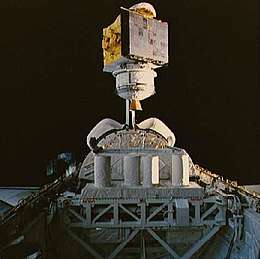Satcom (satellite)
The Satcom series was a family of communications satellites originally developed and operated by RCA American Communications (RCA Americom). Satcom was one of the early geostationary satellites; the first were the Syncom series, in 1964. The first Satcom satellite, Satcom 1, was launched on December 13, 1975. The last satellite, Satcom K2, was placed into orbit on November 27, 1985 and was de-orbited in February 2002. Satcom was first superseded and then replaced by the GE series of satellites.
- "Satcom" is also an acronym of, and generic term for, satellite communications.

Satcom (which stands for "satellite communication") was an artificial geo-stationary satellite that facilitated wide-area telecommunications by receiving radio signals from Earth, amplifying them, and relaying them back down to terrestrial receivers.
The Satcom system passed to General Electric with its purchase of RCA in 1986. RCA Americom became GE American Communications (GE Americom) and the satellite construction division became GE Astro Space. GE Astro Space was sold to Martin Marietta (now Lockheed Martin Space Systems) in 1993. In 2001 GE sold GE Americom to SES Global, creating SES Americom.
History
Most early commercial communications satellites were built for and operated by telecommunications companies. RCA, with its own RCA Astro Electronics satellite construction business, identified a role for itself as a satellite owner/operator.
Satcom 1 was used as the launching ground for many cable TV services including HBO, Showtime, Superstation TBS, Nickelodeon, the FBC Network of Tom Ficara, the CBN cable network (now Freeform), ESPN, and The Weather Channel. The satellite spurred the cable television industry to unprecedented heights with the assistance of HBO (who moved their programming from the competing Westar 1, where they had been since their nationwide debut in 1975, to Satcom 1 in February 1976). Cable television networks relay signals to ground-based cable television headends using satellites, which allowed cable TV to enter into the suburban and metropolitan markets, thus allowing HBO to accumulate 1.6 million subscribers by the end of 1977.
A notable legal battle involved Ted Turner suing RCA to get a Satcom 1 transponder in 1980 for the launch of CNN on June 1, 1980. CNN had been scheduled for a Satcom 3 transponder but that satellite failed to reach geosynchronous orbit upon its launch on December 7, 1979.
Shortly after its launch, Satcom 1 was the first satellite used by broadcast TV networks in the United States. The networks ABC, NBC, and CBS distributed their programming content to some local affiliate stations, which had before relied on AT&T's terrestrial microwave and coaxial networks to distribute & relay programming (although NBC used it on an experimental basis for this purpose in the late 1970s). The networks fed to both Satcom 1 and AT&T's network at the same time (for the benefit of those stations who hadn't yet been equipped with earth station equipment for reception of the satellite) up until the breakup of AT&T in 1984, when the networks switched exclusively to satellite distribution on Satcom 1 (and later satellites), due to the much lower transmission costs, as well as due to AT&T's divestiture itself.
The reason that Satcom 1 was so widely used by both cable and broadcast TV networks is that it had twice the communications capacity of the competing Westar 1 (24 transponders as opposed to Westar 1's 12), which resulted in lower transponder usage costs in general.
Satellite fleet
All the remaining Satcom satellites were retired in the early 2000s and replaced by the GE/AMC series, originally by GE Americom, then sold to SES.
| Model | Manufacturer | Launch date | Launch vehicle | COSPAR ID | Comments |
|---|---|---|---|---|---|
| Satcom 1 | RCA Astro Electronics | December 12, 1975 | Delta 3000 | 1975-117A | |
| Satcom 2 | RCA Astro Electronics | March 26, 1976 | Delta 3000 | 1976-029A | |
| Satcom 3 | RCA Astro Electronics | December 7, 1979 | Delta 3000 | 1979-101A | Failure during GTO (currently in non-geosynchronous orbit) |
| Satcom 1R | RCA Astro Electronics | April 11, 1983 | Delta 3000 | 1983-030A | Replaced Satcom 1 |
| Satcom 2R | RCA Astro Electronics | September 8, 1983 | Delta 3000 | 1983-094A | Replaced Satcom 2 |
| Satcom 3R | RCA Astro Electronics | November 20, 1981 | Delta 3000 | 1981-114A | Replaced Satcom 3 |
| Satcom 4 | RCA Astro Electronics | January 16, 1982 | Delta 3000 | 1982-004A | |
| Satcom 5 | RCA Astro Electronics | October 28, 1982 | Delta 3000 | 1982-105A | Also called Aurora 1, still on 105.2'W (2006) |
| Satcom 4R | Hughes | November 8, 1984 | STS-51-A (Discovery) | 1984-113B | Launched as Anik D2, purchased in orbit |
| Satcom C1 | GE Astro Space | November 20, 1990 | Ariane 42P | 1990-100A | Replaced Satcom 1R |
| Satcom C3 | GE Astro Space | September 11, 1992 | Ariane 44LP | 1992-060B | |
| Satcom C4 | GE Astro Space | August 31, 1992 | Delta II (7925) | 1992-057A | |
| Satcom C5 | GE Astro Space | May 29, 1991 | Delta II (7925) | 1991-037A | Originally called Aurora 2, replaced Aurora 1 / Satcom 5 |
| Satcom K1 | RCA Astro Electronics | January 12, 1986 | STS-61-C (Columbia) | 1986-003B | |
| Satcom K2 | RCA Astro Electronics | November 27, 1985 | STS-61-B (Atlantis) | 1985-109D | |
| Satcom K3 | GE Astro Space | March 2, 1991 | Ariane 44LP | 1991-015A | Sold during construction to SES; launched as Astra 1B |
| Satcom K4 | GE Astro Space | June 10, 1992 | Atlas II | 1992-032A | Sold during construction to Intelsat, launched as Intelsat K |